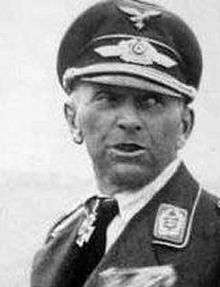Bruno Bräuer
| Bruno Bräuer | |
|---|---|
 Photo of Bruno Braeuer as Colonel | |
| Born |
4 February 1893 Willmannsdorf, Silesia, Kingdom of Prussia, German Empire now Stanisławów, Lower Silesian Voivodeship, Poland |
| Died |
20 May 1947 (aged 54) Athens, Central Greece, Greece |
| Buried at | German War Cemetery at Maleme |
| Allegiance |
|
| Service/branch |
|
| Rank | General der Fallschirmtruppe |
| Commands held | FschJägRgt 1 |
| Battles/wars |
World War II |
| Awards | Knight's Cross of the Iron Cross |
Bruno Bräuer (4 February 1893 – 20 May 1947) was a German paratrooper from Willmannsdorf, Prussian Silesia. In 1905 started his military career, receiving the Iron Cross first and second class during World War I. After joining the Reichswehr, he took command of the first Battalion, General Göring regiment. By 1938 he was in command of the first Fallschirmjäger regiment. He commanded the unit through Poland, France, the Netherlands and the Balkans. Later he became commander on Crete and then commanded the 9th Paratroopers division as a Major General. After the war, Bräuer was convicted of war crimes and executed.
World War II
Bräuer led the regiment in Poland, France and the Low Countries, receiving the Knight's Cross of the Iron Cross. Bräuer's regiment participated in the Battle of Crete, which started on 20 May 1941 when Nazi Germany launched its airborne attack on Crete.
Commander on Crete
In November 1942 Bräuer replaced General Alexander Andrae as commander on Crete. On 25 March, Greek National Day, he released 100 Cretan prisoners from jail. One prisoner, Constantinos Mitsotakis, later became Prime Minister of Greece. After German failures at Stalingrad and El Alamein, Bräuer ordered the construction of underground command bunkers, more defenses around Suda Bay and increased ammunition stocks. Bräuer was replaced by General Friedrich-Wilhelm Müller in 1944.
9th Paratroopers
In January 1945 the German 9th Parachute Division was formed under Bräuer, mostly made up of Luftwaffe ground forces. In January 1945 two of his battalions were encircled by the 1st Ukrainian Front in Breslau, where they were destroyed. The rest of the division retreated back to the Seelow Heights. Many of the troops fled when the Soviet barrage began. Before long, the line had nearly completely collapsed and many of Bräuer’s men began to desert. Bräuer suffered a nervous collapse and was relieved of his command.
Conviction and execution
Along with General Friedrich-Wilhelm Müller, Brauer was charged with war crimes by a Greek military court. He stood trial in Athens for atrocities on Crete. He was accused of the deaths of 3,000 Cretans, massacres, systematic terrorism, deportation, pillage, wanton destruction, torture and ill treatment.[1] Brauer was convicted and sentenced to death on 9 December 1946. He was executed by firing squad at 5 o'clock on 20 May 1947, the anniversary of the German invasion of Crete. The historian Antony Beevor describes him as 'a truly unfortunate man' having been executed for crimes 'committed under another general'.[2]
Burial
Three years later, the Association of German Airborne troops requested that Brauer's remains be moved to Crete and reinterred on hill 107, with German troops killed on the island during the invasion and the occupation. His remains were buried by George Psychoundakis, resistance fighter and author of The Cretan Runner. Brauer's grave can be found in the far left corner of the cemetery next to an unknown soldier.
Awards
- Iron Cross (1914)
- Clasp to the Iron Cross (1939)
- Knight's Cross of the Iron Cross on 24 May 1940 as commander of Fallschjäger-Regiment 1[4]
- German Cross in Gold on 31 March 1942 as commander of Fallschjäger-Regiment 1[5]
- Mentioned in Wehrmachtbericht on 9 June 1941[6]
See also
Notes
References
Citations
- ↑ "Some Noteworthy War Criminals" (archived here), Source: History of the United Nations War Crimes Commission and the Development of the Laws of War, United Nations War Crimes Commission. London: HMSO, 1948, p. 526, updated 29 Jan 2007 by Stuart Stein (University of the West of England), accessed 22 Jan 2010
- ↑ Beevor, Berlin, the downfall 1945, p.236
- 1 2 3 4 Thomas & Wegmann 1986, p. 33.
- ↑ Scherzer 2007, p. 238.
- ↑ Patzwall & Scherzer 2001, p. 57.
- ↑ Die Wehrmachtberichte 1939–1945 Band 1, p. 555.
Bibliography
- Beevor, Antony (1991). Crete, the battle and the resistance
- Beevor, Antony (2002). Berlin, the downfall 1945, Penguin Books, ISBN 0-670-88695-5
- Patzwall, Klaus D.; Scherzer, Veit (2001). Das Deutsche Kreuz 1941 – 1945 Geschichte und Inhaber Band II [The German Cross 1941 – 1945 History and Recipients Volume 2] (in German). Norderstedt, Germany: Verlag Klaus D. Patzwall. ISBN 978-3-931533-45-8.
- Scherzer, Veit (2007). Die Ritterkreuzträger 1939–1945 Die Inhaber des Ritterkreuzes des Eisernen Kreuzes 1939 von Heer, Luftwaffe, Kriegsmarine, Waffen-SS, Volkssturm sowie mit Deutschland verbündeter Streitkräfte nach den Unterlagen des Bundesarchives [The Knight's Cross Bearers 1939–1945 The Holders of the Knight's Cross of the Iron Cross 1939 by Army, Air Force, Navy, Waffen-SS, Volkssturm and Allied Forces with Germany According to the Documents of the Federal Archives] (in German). Jena, Germany: Scherzers Militaer-Verlag. ISBN 978-3-938845-17-2.
- Thomas, Franz; Wegmann, Günter (1986). Die Ritterkreuzträger der Deutschen Wehrmacht 1939–1945 Teil II: Fallschirmjäger [The Knight's Cross Bearers of the German Wehrmacht 1939–1945 Part II: Paratroopers] (in German). Osnabrück, Germany: Biblio-Verlag. ISBN 978-3-7648-1461-8.
- Die Wehrmachtberichte 1939–1945 Band 1, 1. September 1939 bis 31. Dezember 1941 [The Wehrmacht Reports 1939–1945 Volume 1, 1 September 1939 to 31 December 1941] (in German). München, Germany: Deutscher Taschenbuch Verlag GmbH & Co. KG. 1985. ISBN 978-3-423-05944-2.
| Military offices | ||
|---|---|---|
| Preceded by Generalleutnant Gustav Wilke |
Commander of 9. Fallschirmjäger-Division 2 March 1945 – 18 April 1945 |
Succeeded by Oberst Harry Herrmann |